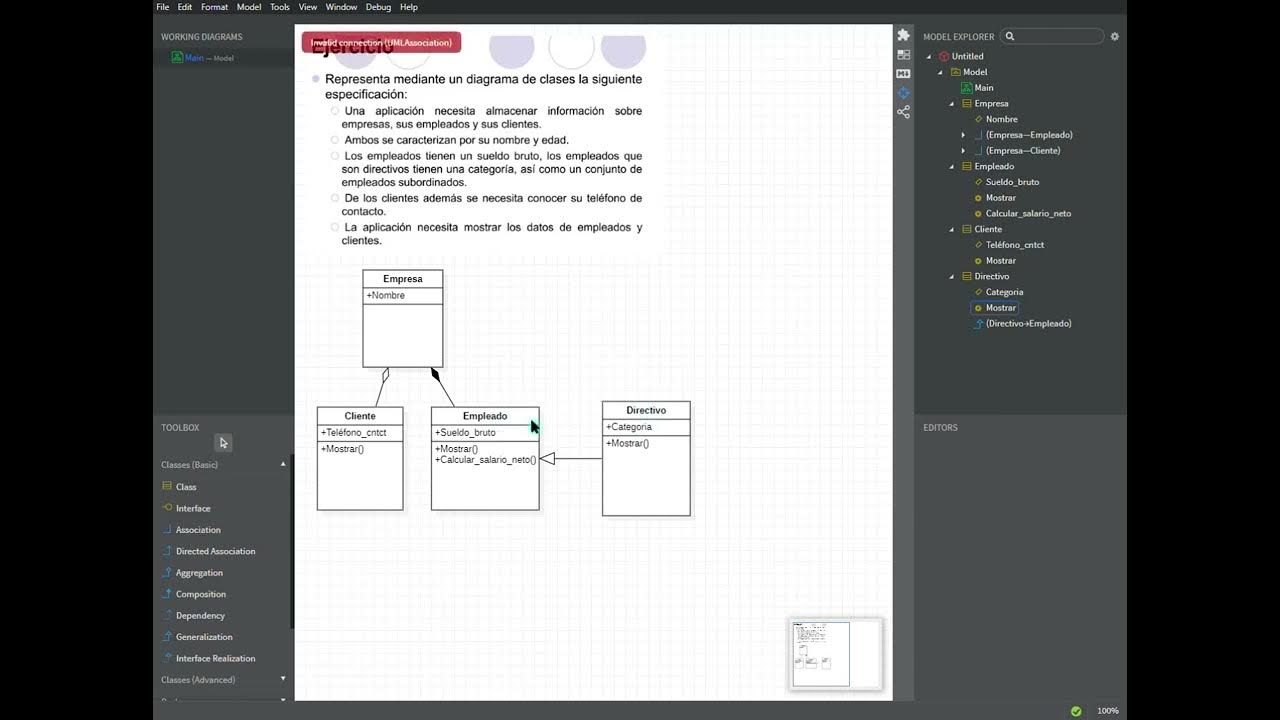UML class diagrams
Summary
TLDREste tutorial detalla los diagramas de clases UML, explicando características básicas como atributos y métodos, y cómo se representan. Cubre visibilidad, con ejemplos de privada, pública, protegida y paquete. Explora relaciones entre clases como herencia, asociación, agregación y composición, con multiplicidad. Finaliza con un ejemplo real de un carrito de compras en línea, mostrando cómo se aplican estos conceptos en la programación.
Takeaways
- 🐻 El video enseña sobre diagramas de clases UML, comenzando con las características básicas.
- 🐘 Se usa el ejemplo de un sistema para un zoológico para explicar cómo funcionan las clases en UML.
- 📦 Una clase representa una entidad en el sistema y contiene atributos (como nombre, id y edad) y métodos (como setName y eat).
- 🔒 La visibilidad en UML define si los atributos y métodos son públicos (+), privados (-), protegidos (#), o por defecto (~).
- 🧬 La herencia permite que las clases hijas hereden atributos y métodos de una clase padre, como el ejemplo de los animales del zoológico.
- 🌀 La abstracción se utiliza para simplificar un sistema, haciendo que clases como 'Animal' sean abstractas y no se puedan instanciar.
- 🔗 Las relaciones de asociación conectan clases sin crear dependencias, como la relación entre un 'otter' y un 'sea urchin'.
- ⚙️ La agregación es un tipo de asociación en la que las partes pueden existir fuera del todo, mientras que la composición implica que las partes no pueden existir sin el todo.
- ➕ La multiplicidad en UML define cuántas instancias de una clase pueden estar relacionadas con otra, como una o varias salas de baño por centro de visitantes.
- 🛒 El ejemplo final muestra un sistema de carrito de compras en línea, donde las relaciones y la multiplicidad se aplican entre clases como 'User', 'Customer', y 'Order'.
Q & A
¿Qué es un diagrama de clases en UML?
-Un diagrama de clases en UML es una representación gráfica de las clases que forman parte de un sistema, mostrando sus atributos, métodos y las relaciones entre ellas.
¿Cómo se representa una clase en un diagrama de clases?
-Una clase se representa con un rectángulo dividido en tres secciones: el nombre de la clase en la parte superior, los atributos en el centro y los métodos en la parte inferior.
¿Qué es un atributo en una clase y cómo se representa?
-Un atributo es un dato que describe una instancia de una clase. Se representa con su nombre seguido de dos puntos y el tipo de dato que retorna. Por ejemplo, 'nombre: String' indica que el atributo nombre es de tipo cadena de texto.
¿Qué es un método en una clase y cómo se formatea?
-Un método es una función que define el comportamiento de una clase. Se formatea empezando con la visibilidad (por ejemplo, + para público o - para privado), seguido del nombre del método y los paréntesis. Puede incluir parámetros y su tipo de dato.
¿Qué son la visibilidad y los símbolos que la representan?
-La visibilidad indica el nivel de acceso de los atributos y métodos de una clase. Los símbolos son: '+' para público, '-' para privado, '#' para protegido y '~' para paquete o default.
¿Qué es una relación de herencia en UML?
-Una relación de herencia, o generalización, permite que una clase hija herede atributos y métodos de una clase padre. Se representa con una flecha abierta desde la clase hija hacia la clase padre.
¿Qué es una clase abstracta y cómo se representa?
-Una clase abstracta es una clase que no puede ser instanciada directamente, solo a través de sus subclases. Se representa colocando el nombre de la clase en cursiva.
¿Qué es una relación de asociación y cómo se representa?
-Una asociación es una relación simple entre dos clases. Se representa con una línea simple entre las clases. Por ejemplo, si una nutria come erizos de mar, se dibuja una línea entre 'nutria' y 'erizo de mar'.
¿Qué es la agregación y cómo se distingue de la composición?
-La agregación es una relación donde las partes pueden existir de forma independiente del todo, y se representa con un diamante abierto. En la composición, las partes no pueden existir sin el todo, y se representa con un diamante cerrado.
¿Qué es la multiplicidad en UML y cómo se usa?
-La multiplicidad especifica cuántas instancias de una clase pueden estar relacionadas con otra clase. Por ejemplo, '1' significa una instancia, '0..*' significa de 0 a muchas instancias. Se coloca junto a la línea que conecta las clases.
Outlines

Esta sección está disponible solo para usuarios con suscripción. Por favor, mejora tu plan para acceder a esta parte.
Mejorar ahoraMindmap

Esta sección está disponible solo para usuarios con suscripción. Por favor, mejora tu plan para acceder a esta parte.
Mejorar ahoraKeywords

Esta sección está disponible solo para usuarios con suscripción. Por favor, mejora tu plan para acceder a esta parte.
Mejorar ahoraHighlights

Esta sección está disponible solo para usuarios con suscripción. Por favor, mejora tu plan para acceder a esta parte.
Mejorar ahoraTranscripts

Esta sección está disponible solo para usuarios con suscripción. Por favor, mejora tu plan para acceder a esta parte.
Mejorar ahoraVer Más Videos Relacionados

Tutorial - Diagrama de Clases UML

CASO USO UML

• Tutorial de como usar StarUML

Lógica de la Programación Orientada a Objetos Explicada con FIFA

La historia de UML | 3/38 | UPV

Ingeniería del Software II - Modelado de clases con UML - Fernando Pereñiguez

65. Programación en Java || POO || Método Constructor
5.0 / 5 (0 votes)